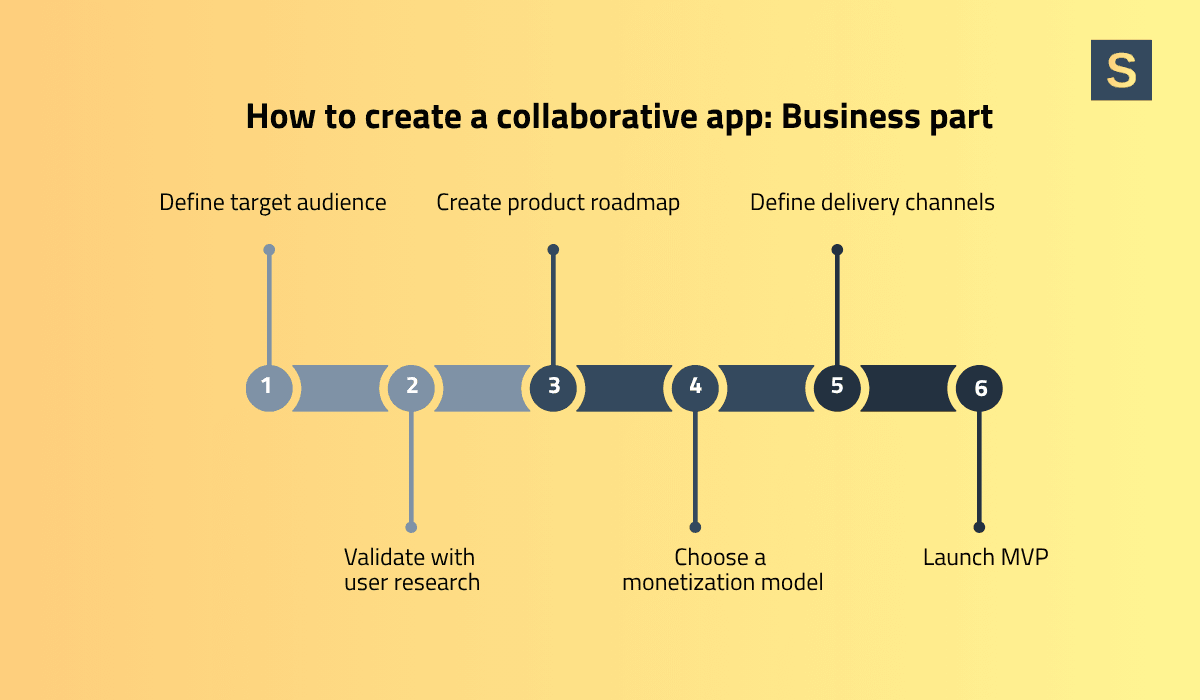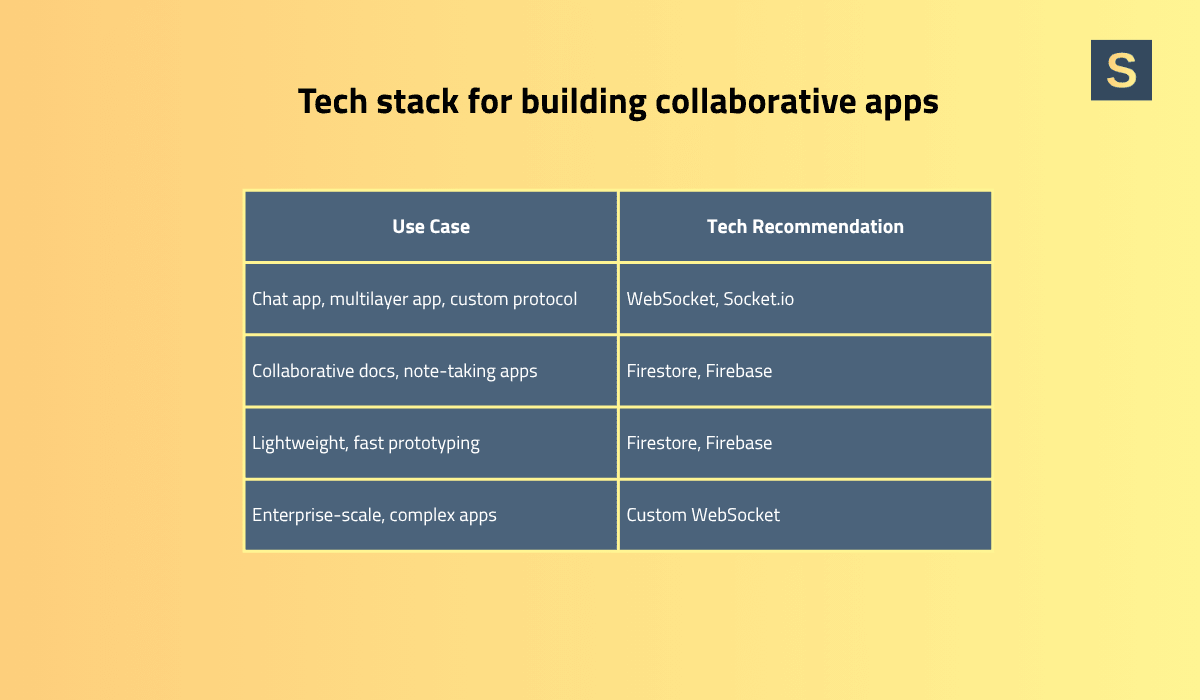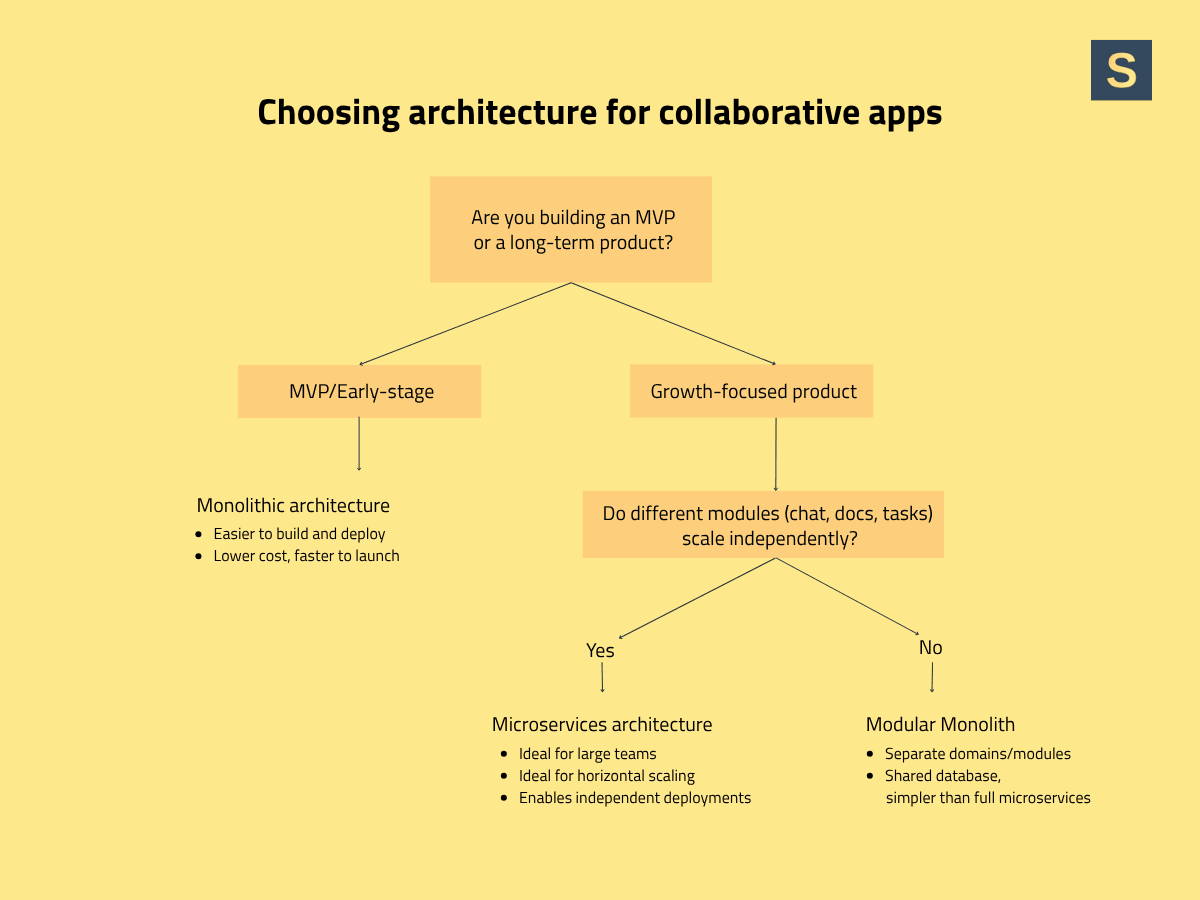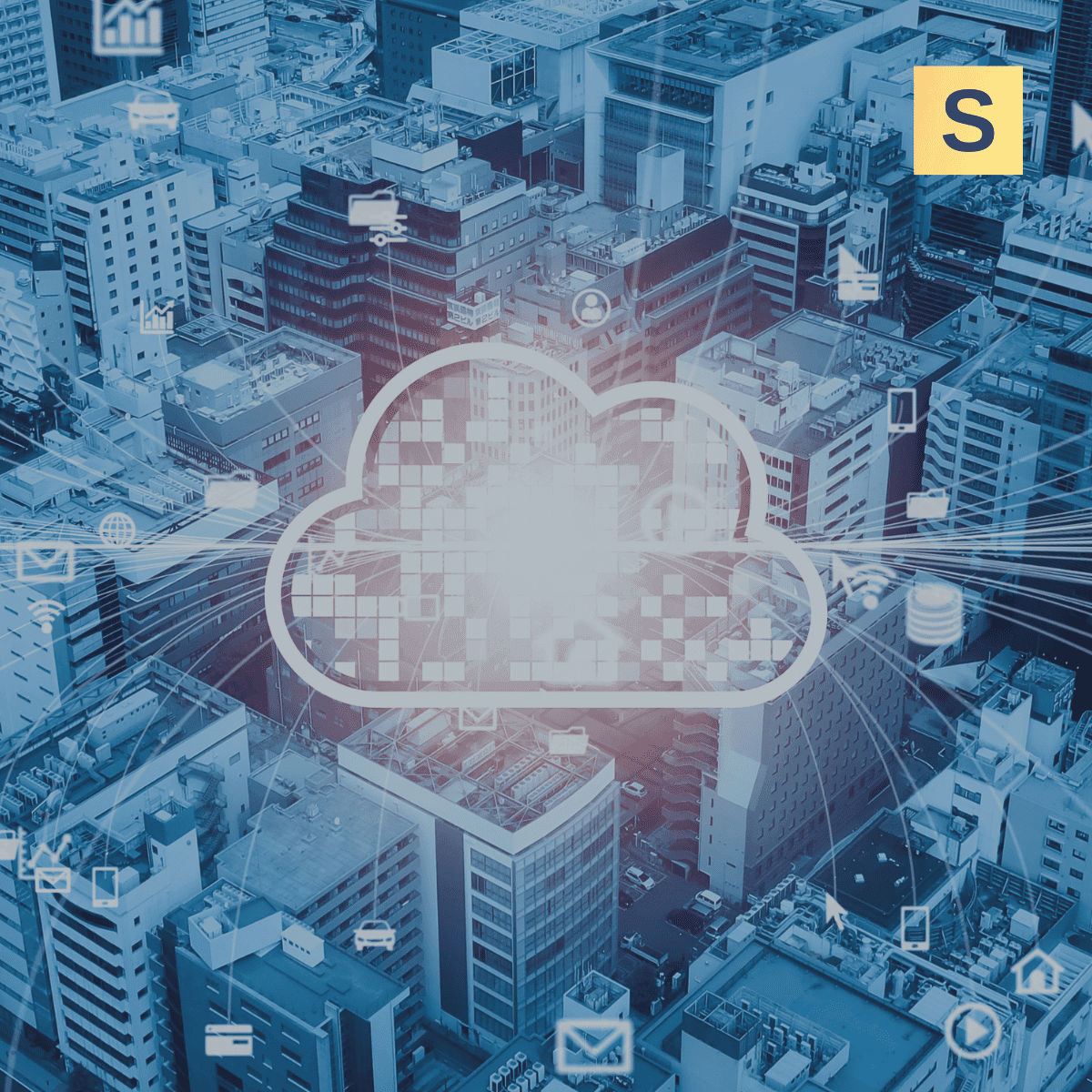Collaborative application development is not a trivial project. This solution must provide reliable real-time interaction between multiple users, as well as ensure data consistency across all devices, support seamless synchronization, and maintain high performance under varying network conditions.
Whether you want to help creatives share ideas in real time, enable teams to co-edit documents, or build the next big project management tool, you need to get both the business model and the technology stack right.
This guide is here to answer the questions that every founder asks when thinking about how to build a collaborative web app:
- Which features matter most for my users?
- How to choose the right architecture and technologies for real-time sync?
- How to ensure the required security and scalability for such solutions?
What is a collaborative application?
A collaborative app is a software platform where multiple users can work on shared tasks in real time. In practice, such applications enable teams to share documents, manage tasks, exchange information, and communicate in one place.
Here are the main characteristics of collaborative apps that describe this type of software the best:

Multi-user access & roles
There is support for multiple users who have assigned roles (e.g., admin, editor, or viewer) with associated permissions. Presence indicators (e.g., "User A is editing") are common, so everyone knows who's online and working.
Real-time synchronization
Any modifications by one user are instantly accessible to others. This usually entails a real-time data layer. More sophisticated apps use conflict-resolution strategies like Operational Transformation (used in Google Docs) or CRDTs to avoid data inconsistency when multiple users edit the same content simultaneously.
Shared workspaces or content
Collaborative software provides a centralized space (folders, boards, projects, repositories, etc.) where team artifacts live. An example is a photo‑proofing software that has shared image galleries or a docs platform that has shared files and version history. Shared workspaces such as these have version control, commenting, and annotation.
Communication integration
Integrated communication tools are an essential part of collaborative software that help teams to interact without switching apps. They can include an in-app chat pane, commenting threads on a document, or even live video calls. Integration with outside comms such as Slack or Zoom is also common.
Cross-platform availability
Team collaboration tools run primarily on the web and mobile (and sometimes desktop). Users expect to have an equivalent experience across any device. There are different tech approaches to provide cross-platform functionality.
For example, you can use frameworks like React + React Native or Progressive Web Apps (PWAs) to enable the sharing of code across platforms.
Read also: React vs Angular: What to Choose for Your Next Web Project
What are the key features of collaborative software?
When building a collaboration platform, the specific feature set will differ depending on your use case. Here are some of the most popular feature options:
- Real-time editing and updates: Live co-editing of boards, whiteboards, or documents. Users see others' edits in real-time.
- Messaging and chat: Group chat and direct messages (with @mentions, threads, etc.) for easy discussion. Usually includes voice/video calls and screen sharing for more inclusive communication.
- File sharing & document collaboration: Uploading and sharing files. Locking, versioning, or co‑editing of documents. For example, a feature can automatically sync files or facilitate drag‑and‑drop sharing in chat.
- Task and project management: Tasks, checklists, Kanban boards, or Gantt charts feature that let you assign tasks to users, set due dates, and monitor progress. Trello and Asana are popular examples here.
- Notifications & activity feed: Mentions, comments, or task status update notifications to keep users in the loop. Activity logs and dashboards that record recent changes help teams quickly see project status
- User presence & history: Online/offline presence indicators, read receipts, and edit histories. This raises awareness – i.e., "John is online" or "Jane edited this doc at 3:05 PM".
- Access control: Fine-grained permission control. Only certain users enter certain workspaces or perform specific actions. Admins allow/deny access, or generate shareable private URLs, etc.
- Integrations and APIs: Most collaboration platforms integrate with other platforms (Slack, GitHub, Dropbox, etc.) or offer APIs/Webhooks so you can add some functionality or automate a process.
Collaborative team software now offers more and more combined project management (file sharing, charts, tasks) with voice/video, real-time chat, and shared document editing. In other words, the key to any collaboration app is getting the coordination and communication to occur in a single workspace. This boosts user engagement and retention.
How to create a collaborative app: business considerations
Before diving into the nuances of tech implementation, you must ensure you have a solid product roadmap. In our experience, the most successful startups are those that created a detailed business plan before investing in development, because things like a monetization model and promotion strategy shape the technical aspects of the product.

1. Business analysis
Begin by identifying your target audience, their workflow, and the problem that your collaboration app can address for them. Do user interviews or research and determine pain points. As difficult as it may sound, you shouldn't skip this step because you risk developing a product that has no market appeal. You don't have to form large focus groups. Start small by conducting surveys in online communities, like Reddit, Quora, and Indie Hackers, to validate your idea.
This research phase will help you shape your concept into specific features and requirements that you can then communicate to software developers.
At Seedium, we provide a dedicated Discovery Phase service designed to help business leaders refine and finalize their product ideas, especially when internal resources are limited or unavailable.
2. Software delivery model
Most modern collaboration apps are being launched as SaaS (Software-as-a-Service) platforms. SaaS enables on-demand access and makes it simpler to update, onboard, and scale. You can also consider PaaS or IaaS in your tech stack (e.g., hosting on AWS or Azure), but SaaS is generally the more familiar option for users.
Read also: SaaS Development Guide for Business Leaders
3. Monetization strategy
How you’re going to monetize your collaboration app can also influence the functionality of the product. Collaboration tools usually avoid ads as they derail professionals. Standard models are subscription (annual/monthly plans) and freemium.
For example, you might have a free plan with basic features and charge extra for more advanced functionality such as additional storage, more members, and analytics. One-time licenses are uncommon in cloud-based apps as they limit long-term revenue.
4. Delivery & support
Decide if you’ll sell directly or through partners. Many collaboration apps are aimed at teams, so think about sales to businesses (enterprise licensing) versus viral spread in smaller teams. Also, consider whether you’ll support multiple languages or regions and what security and compliance requirements your product must meet.
5. Analytics & growth
Even at the business idea level, consider metrics to track the progress of your solution (user adoption rates, churn, engagement). Develop analytics early to be able to track how teams are using your app. We advise launching an MVP rapidly and then watching for usage to inform future feature development.
What tech stack is best for building a collaborative app?
After setting your business and feature goals, the second step is choosing the right technology stack and architecture for real-time collaboration. Let’s go through the six main technology choices your development team needs to make.
1. Platform type (Web, Mobile, PWA)
The first thing you need to decide is if your app is web-only, mobile (iOS/Android), or both.
The majority of startups develop a web app first for a broader reach and then scale to mobile apps. Another option is to use Progressive Web App technology so that a single web codebase acts like a native app with offline capabilities. PWA support is especially helpful if you need to have instant cross-platform access and even offline access via service workers.
Ultimately, the best option is the one that helps you achieve your business goals. You know your potential users and their preferences best.
2. Real-time data synchronization
The core of collaboration is instant data exchange. There are many tech options to allow any change to be broadcast to all connected clients. You can use WebSocket-based systems, WebRTC, or managed services like Firebase Realtime Database or Firestore.
For example, WebSocket-based solutions provide more control over the communication protocol, latency, and architecture, but require custom implementation of some features. On the other hand, managed services are easier to implement, but they may lack customization and flexibility for complex projects.

If high-frequency, low-latency data exchange is crucial for your project, a solution based on WebSockets or WebRTC is likely more appropriate, as both offer persistent connections with minimal overhead and faster message delivery.
3. Conflict resolution
When many users are editing the same content, you must merge edits without any loss of information. Operational Transformation (OT) and Conflict-Free Replicated Data Types (CRDTs) are two well-known techniques:
- OT translates incoming edits so that concurrent operations can be merged sequentially.
- CRDTs use data structures that merge conflicting edits automatically on reconnect.
Both ensure eventual consistency (everyone sees the same result). Libraries like Yjs or ShareDB implement CRDTs for rich text and other shared objects. It’s wise to plan for offline edits: users should be able to make changes while offline, with the system syncing changes when back online.
4. Scalable Architecture
In most cases, it’s easier to start with monolithic architecture. But if you know from the start that you’re building a solution with distinct components that can grow independently, microservices are a wise option.
At Seedium, we often use a hybrid approach. Basically, we build a monolithic architecture divided into several modules. In this setup, a single database with separate modules is maintained, while Apache Kafka serves as the central messaging layer that connects them.
This architecture scales well with business growth, makes it easier to maintain changes in the project, and, if necessary, allows you to connect a clean microservice architecture.

Read also: Monolithic vs Microservices: What Architecture To Choose For Your Project
5. Event-Driven Backend
Much of a collaborative app is inherently event-driven. Each time a user action is performed, the backend sends out events that are listened to by other services (and other users). Services can be decoupled by using an event bus or message broker. For example, a particular "message sent" event may trigger:
- Sending the message to WebSocket clients.
- Storing it in the database.
- Notifying offline users by email or push.
This pattern makes it easier to implement features like presence indicators (who's online/typing) or activity feeds since they can subscribe to the respective events.
6. Security
Security is a top concern in collaboration tools, so you need to follow the best practices to protect your app from vulnerabilities:
- Authentication and authorization should use robust standards.
- Use OAuth2/OpenID Connect or SSO, especially if you are targeting enterprises.
- Use at least JWTs or the like for sessions.
- Implement role-based access control (RBAC) as users must only view or modify what they're permitted to.
- Use TLS encryption where applicable (HTTPS) and encrypt sensitive data at rest.
- Include audit logs to record who did what, when, in case of needing to find any issues later.
Read also: Cybersecurity Essentials for Software-Centric SMBs
Case study #1: Designing a collaborative app for women-owned businesses
At Seedium, we have vast experience in developing collaborative software solutions. Let me share some of our projects.
HerHeadquarters is a cross-platform collaborative application aimed at uniting women entrepreneurs and freelancers within the Fashion, Beauty, Entertainment, Events, and Public Relations industries. Our team took care of all the development tasks, including UX/UI, front-end, and back-end app development.
Key solutions:
- Developed a cross-platform mobile app using React Native with an offline-first approach as well as high-security standards of JWT authentication.
- Provided an additional option to manage accounts not only inside the mobile application but also using web platform functionality.
- Implemented searching, filtering, and sorting features for improved app navigation.
- Implemented real-time chat between users with the ability to send files, including text, videos, and images.
- Integrated with Stripe as a payment system.
Results and client feedback:
The app was launched successfully in 2019 and expanded to a desktop platform in 2024. HerHeadquarters is going from a simple app to a powerful movement recognized by the U.S. Congress, Forbes, American Express, and more.
"They were flexible, their communication was strong, and they always had ideas that would make the product better."
Carina Glover, CEO of HerHeadquarters
Case study #2: Building a collaborative platform for creatives
Picflow is a modern collaboration platform for creative professionals designed to share, proof, and transfer media files. It helps photographers, designers, agencies, and other creatives easily collaborate with clients on visual content.
Key solutions:
- Scalable cloud-based infrastructure powered by AWS to support image uploads and downloads without compromising quality.
- Sharing and security features allow users to have full control over who sees their work with public, private, or unlisted settings.
- Flexible review tools that accelerate the approval process.
- Third-party integrations, including Stripe, Clerk, marketing automation tools, and CMS integrations.
Results and client feedback:
The result of our collaboration with the client was a fully operational SaaS platform that unites over 10k registered users. We continue to help Picflow scale and grow with new functionality.
“They were very professional, forward-thinking, and pleasant to work with. We had the feeling that they were part of the team and had skin in the game. That stood out from other experiences I had with some partners.”
Michel Luarasi, Founder of Picflow
What are the challenges and best practices for collaborative app development?
Building a collaboration app may involve some unique challenges that you need to prepare for. Here are some of the most significant ones and how to address them.
1. Delivering a seamless real-time experience
Challenge. Instant updates, lag-free. Any delay whatsoever kills the flow of collaboration.
Solution:
- Invest early in real-time infrastructure.
- Focus your MVP on perfecting one real-time feature first, such as getting document co-editing or chat flawless, before adding the rest.
We recommend minimizing latency (shortening round-trip time). You can also use optimistic UI updates on the client to create the illusion of instant response.
2. Secure access and permissions
Challenge. As collaboration often involves sensitive data, with no robust access controls, users can view or update things they shouldn't.
Solution:
- Implement fine‑grained access control from day one.
- Implement RBAC so that each feature verifies the user's role, e.g., implement "admin" vs. "member" permissions and implement these on all APIs.
- Add enterprise‑level auth (SSO, OAuth, 2FA) if needed.
- Implement secure defaults (private workspaces by default) and simplify data sharing (expiring links, guest accounts).
Features such as audit logs and encrypted storage help with compliance and traceability.
3. Scaling real-time infrastructure
Challenge. Collaboration apps can have hundreds or thousands of users over dozens of active sessions. Blindly sending to all of them can become a bottleneck.
Solution:
- Use event-driven patterns and scalable services. For instance, load your messaging onto a scalable pub/sub system (like Kafka or AWS SNS) so that you can add servers behind it.
- Monitor key real-time KPIs (e.g., per-server connections, message rate) and scale capacity when needed.
- Sharding (e.g., split users by team or topic to designated channels) is another option to localize traffic.
Decoupling services and cloud auto-scaling enable you to handle spiky collaborative work (e.g., thousands of concurrent edits) without system failure.
Why choose Seedium for building your collaborative app?
Seedium brings end-to-end expertise and cross-domain know-how to strategic partnerships. We have led startups in launching complex platforms in SaaS, healthcare, HRTech, AI, and more since 2017. Our flexible models of engagement enable you to use us as a dedicated team or as a full-service dev partner. With over 200 successful projects, we are trusted for our rapid and high-quality delivery.
Looking for an experienced tech partner to support your product development? Contact us today to discuss your project needs!





